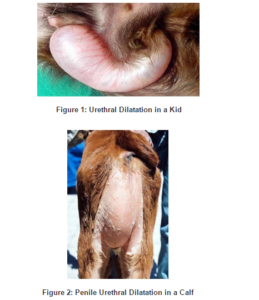UROLITHIASIS
Shikha Bishnoi*, Ghanshyam sahu, Pradhuman Bishnoi
*Corresponding Author- shikhabishnoi29@gmail.com
BVSc, MVSc
Indian Veterinary Research Institute, Bareilly, 243122
Urolithiasis (Urinary calculi) refers to the deposition of crystals of various salt in any part of animal’s urinary tract. Generally, Calculi or stone are observed in renal tubules or urinary bladder. Urolithiases has got species, sex and site specificity. It is more common in male calf and dog (especially more common in male). The stone may get formed in pelvis of kidney, in the parenchyma of kidney, ureter, urinary bladder, neck of bladder and urethra.
Composition: The Composition of stone varies from species to species.
- In dog, stone is composed of triple phosphate crystals. Other crystals are of calcium oxalate and calcium phosphate.
- In cattle, stone are composed of calcium, magnesium and ammonium phosphate.
- In horse, stone are composed of calcium carbonate, magnesium phosphate and magnesium carbonate.
- In goat and sheep, stones are composed of calcium phosphate, magnesium phosphate and ammonium phosphate.
- In pig, calcium carbonate, magnesium carbonate, magnesium phosphate, and magnesium oxalate are the major constituents.
Aetiology-
- Altered pH: Low pH prevents the deposition of salts, stabilizes the protective colloid and thus prevent deposition of inorganic constituents in the urinary tract.
- Increased concentration of crystals over colloid: Urine contain certain substances like mucoprotein, hyaluronic acid which prevent deposition of inorganic constituents in the form of crystals, i.e., from the ‘sol’ to ‘gel’ state.
- Dehydration and inadequate water supply: It will cause decreased urinary output. Excess concentration of urine will facilitate deposition of urinary crystal.
- Infection of urinary tract will lead to desquamation of epithelium, production of necrotic tissues and accumulation of bacteria. This along with fibrin, mucus and blood cell will form a nidus on which inorganic crystals are deposited.
5. Hard water, excessive intake of calcium and vitamin D may predispose the condition.
6. Urinary stasis and avitaminosis-A have also been incriminated as predisposing factor.
7. Excessive intake of sulphonamide may help in the precipitation of condition.
8. High level of Estrogen has also been suggested as contributory factor.
Clinical findings-
There are certain clinical findings that bring forth several symptoms of this disease. They are:

- Severe pain on palpation.
- Haematuria.
- Rupture of bladder.
- Vomiting in dog and cat.
- Dysuria and urinary incontinence.
- Uraemia.
Diagnosis-
In the further process of diagnosis, the mentioned steps are taken for the confirmation of urolithiasis:
- Examination of urine for crystals
- Serum biochemistry- urea and creatinine level increased
- Radiography- detection of radio dense calculi
- Ultrasonography
Line of treatment-
Though this disease is highly curable as the symptoms are likely visible before a certain time-period. So, a proper diagnosis, along with treatment works as a cure. The various line of treatments is as mentioned:
- Alteration of pH with acidifier and alkaliser according to pH.
- Check infection with appropriate antibiotics.
- Control blood urea in small animal with Ciploric (Cipla) tablet – 100mg BID orally.
- Cystone tab may be given.
- Surgery: – Cystotomy and urethrotomy.



